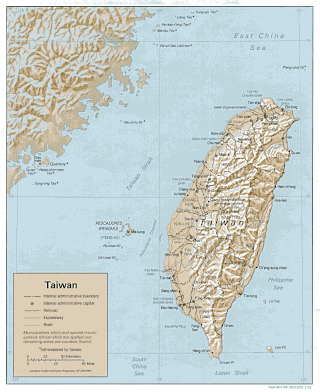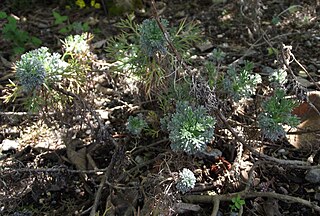
Taipei, officially Taipei City, is the capital and a special municipality of Taiwan. Located in Northern Taiwan, Taipei City is an enclave of the municipality of New Taipei City that sits about 25 km (16 mi) southwest of the northern port city of Keelung. Most of the city rests on the Taipei Basin, an ancient lakebed. The basin is bounded by the relatively narrow valleys of the Keelung and Xindian rivers, which join to form the Tamsui River along the city's western border.

National Sun Yat-sen University is a public research university located in Sizihwan, Kaohsiung, Taiwan. NSYSU is listed as one of six national research universities, and one of four universities that make up the Taiwan Comprehensive University System, a research-led university alliance in Taiwan. With AACSB and CFA accredited and the number one maritime management program in Asia, the NSYSU College of Management is among the best in East Asia, and the College of Marine Sciences is the oldest and highest ranked in Taiwan.

China's vast and diverse landscape is home to a profound variety and abundance of wildlife. As of one of 17 megadiverse countries in the world, China has, according to one measure, 7,516 species of vertebrates including 4,936 fish, 1,269 bird, 562 mammal, 403 reptile and 346 amphibian species. In terms of the number of species, China ranks third in the world in mammals, eighth in birds, seventh in reptiles and seventh in amphibians.

The flora of Taiwan is rich and varied due to the island's diverse geography and climate zones. The main island is situated on the Tropic of Cancer between China and the Philippine Sea basin. There are mountains in the east, running north and south on two-thirds of the island, with many peaks over 10,000 feet in elevation, and lower, flatter, and more fertile land to the west. The tropical climate, plentiful rainfall, and wide altitudinal range make for abundant and varied vegetation. Taiwan is home to over 4300 species of vascular plants, of which it is estimated that 600 are ferns, 28 are gymnosperms, 2400 are dicots, and 1000 are monocots.

Dendrocnide meyeniana or the poisonous wood nettle is a species of tree in the family Urticaceae, native to the thickets and secondary forests of Taiwan and the Philippines. The specific epithet meyeniana honors Franz Meyen, who collected the type specimen in Manila during his world cruise.
Chen Da (also Chen Ta; Chinese: 陳達; pinyin: Chén Dá; Wade–Giles: Ch'en2 Ta2; Pe̍h-ōe-jī: Tân Ta̍t; b. 1905 (1906?) – d. April 11, 1981) was a Taiwanese folk singer. He was part of Taiwan's folk music scene and worked as an analphabetic creator of lyrics. His spontaneous performances of traditional tunes became an object of study for many scholars focused on the music of Taiwan and brought him to the attention of writers engaged in music criticism including the novelist Wang Tuoh. According to the Journal of Music in China, Chen Da was "the only noted singer of Taiwanese folk singing." Chen Da is also referred to as a singer of "Hoklo folk songs," a synonym of "Taiwanese folk songs."

Acer kawakamii is an Asian species of maple, found only in Taiwan. The species is sometimes confused with another Taiwanese tree, Acer morrisonense. This species has been known to reach 20 metres tall. Leaves are non-compound, the blade narrowly ovate, up to 11 cm long by 4.5 cm wide, with serrate margins but no lobes.

Rhododendron kawakamii is a plant endemic to Taiwan. It is also called Kawakami's rhododendron, as the type specimen was collected by Takiya Kawakami and others from Mount Niitaka. This species is the only native, epiphytic, yellow flowered rhododendron in Taiwan, and is scattered in the fog forest belt of the island at an altitude of about 1,500 to 2,500 m. It was first published as a new species by Bunzo Hayata in 1911. The wild community was assessed as "near-threatened" in the Taiwan Red Book of Vascular Plants in 2017.
Piper kawakamii, also known as the Kawakamii pepper, is a flowering plant in the family Piperaceae. It is a native endemic species in Taiwan. The plant is mainly distributed in the Hengchun Peninsula. It was collected by Takiya Kawakami at the Kuraru Community, on July 2, 1906. In 1911, the plant was published by Bunzō Hayata as a new species. The type specimen of this plant is being preserved in the Botanical Gardens, Graduate School of Science, the University of Tokyo, Japan.and the Herbarium of Taiwan Forest Research Institute
Lonicera kawakamii, also known as Yushan honeysuckle or Kawakami’s honeysuckle, is a species of flowering plant in the family Caprifoliaceae. It is endemic to Taiwan, where it is found at altitudes between 3000 and 3900 meters. It as rated as “Vulnerable” in the “Red List of Vascular Plants of Taiwan, 2017”.

Sabia swinhoei, known as Swinhoe's sabia, is a species that belongs to the Sabia genus in the Sabiaceae family. It was first published as a new species in Taiwan in 1886.

Artemisia kawakamii, commonly known as Kawakami's mugwort, is a plant in the Artemisia genus under the Asteraceae family that is endemic to Taiwan. The plant is distributed on the Taiwan island, growing at elevations from 2,700 to 3,300 m. It is commonly found in gravelly, open, and arid slopes. The species has yet to be cultivated.

Sedum sekiteiense is a Taiwan-endemic species of the family Crassulaceae in the Sedum genus. It is also one of the few wild plants named after Shiding. The species was first published by Yoshimatsu Yamamoto in 1934 in the Supplementa Iconum Plantarum Formosanarum. Although its taxonomic status has been stable, little is known about its ecological habits due to its rarity, limited distribution, and habitats that are often located on steep and inaccessible cliffs that are difficult to observe. The species is classified as “Vulnerable (VU)” in “The Red List of Vascular Plants of Taiwan, 2017.”









